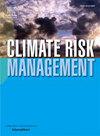气候变化和极端天气预警对美国缺血性心脏病死亡率的影响
IF 5
2区 环境科学与生态学
Q1 ENVIRONMENTAL SCIENCES
引用次数: 0
摘要
为了支持减少极端气候暴露带来的健康风险的适应战略,必须更好地了解温度对健康的影响并评估现有预警系统的有效性。本研究使用2015年至2022年的美国面板数据,估计温度和极端天气预警对缺血性心脏病(IHD)死亡率的阈值效应。首先应用面板阈值模型来确定温度-IHD死亡率关系中是否存在温度阈值,并使用泊松准最小方差来估计温度和极端天气预警对不同温度范围内IHD死亡率的影响。我们发现单一温度阈值范围从16.4°C(滞后1-4)到17.6°C(滞后0)。较冷的气温导致较高的艾滋病死亡率,气温下降在较暖的天气中产生的不利影响更大。在全国范围内,IHD死亡率的增加还与流感流行率升高、COVID-19不良住院治疗、温暖天气下气压升高以及寒冷天气下PM2.5暴露量升高有关。极端天气预警的有效性因温度范围和气候区域而异。风寒警报(WCW)的发布与全国每个州每周IHD死亡人数估计减少2-3人有关,西北和西南地区每周IHD死亡人数减少约3-4人。过热预警(EHW)在全国范围内没有保护作用,但在西部降低了死亡率。该研究为气候因素和极端天气预警如何影响不同温度范围内的IHD死亡率提供了新的见解,提出了加强主动措施以适应气候变化的建议。本文章由计算机程序翻译,如有差异,请以英文原文为准。
Impacts of climate change and extreme weather warnings on ischemic heart disease mortality in the United States
To support adaptation strategies that reduce health risks from extreme climate exposure, it is essential to better understand the health impacts of temperature and evaluate the effectiveness of existing early warning systems. This study estimates the threshold effects of temperature and extreme weather warnings on ischemic heart disease (IHD) mortality, using U.S. panel data from 2015 to 2022. A panel threshold model was first applied to determine if temperature thresholds exist in the temperature-IHD mortality relationship, and Poisson Quasi-MLE was used to estimate the impacts of temperature and extreme weather warnings on IHD mortality across various temperature ranges. We found single temperature thresholds ranging from 16.4 °C (lag 1–4) to 17.6 °C (lag 0). Colder temperatures contribute to higher IHD mortality rates, with temperature decrease having a more adverse impact in warmer weather. Nationwide, increased IHD mortality is also associated with higher influenza prevalence, adverse COVID-19 hospitalizations, and increased air pressure in warm weather, as well as elevated exposure in cold weather. The effectiveness of extreme weather warnings varies across temperature ranges and climate regions. Wind chill warnings (WCW) issuance is associated with an estimated 2–3 fewer IHD deaths per state per week nationwide and about 3–4 fewer IHD deaths per week in the Northwest and Southwest regions. Excessive heat warnings (EHW) had no protective impact nationwide but reduced mortality in the West. The study provides new insights into how climate factors and extreme weather warnings affect IHD mortality across temperature ranges, proposing enhanced proactive measures to adapt to climate change.
求助全文
通过发布文献求助,成功后即可免费获取论文全文。
去求助
来源期刊

Climate Risk Management
Earth and Planetary Sciences-Atmospheric Science
CiteScore
8.20
自引率
4.50%
发文量
76
审稿时长
30 weeks
期刊介绍:
Climate Risk Management publishes original scientific contributions, state-of-the-art reviews and reports of practical experience on the use of knowledge and information regarding the consequences of climate variability and climate change in decision and policy making on climate change responses from the near- to long-term.
The concept of climate risk management refers to activities and methods that are used by individuals, organizations, and institutions to facilitate climate-resilient decision-making. Its objective is to promote sustainable development by maximizing the beneficial impacts of climate change responses and minimizing negative impacts across the full spectrum of geographies and sectors that are potentially affected by the changing climate.
 求助内容:
求助内容: 应助结果提醒方式:
应助结果提醒方式:


